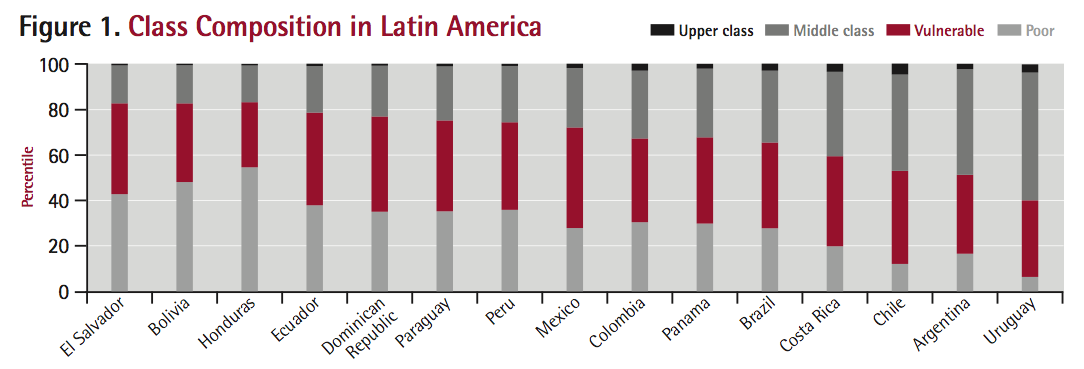The subject of Latin America’s middle class has been in the news frequently over the past few years. Together with Sub-Saharan Africa, Latin America exhibits the highest degree of income inequality in the world . Therefore Latin America’s middle class is often a hotly debated subject.
But how large is Latin America’s middle class? Different studies have yielded a wide range of estimates: anywhere between 170 and 350 million people. Why these disparate figures? Because the method used to measure the size of the middle class differs.
Somewhere Between Rich and Poor
It is not difficult to settle on a definition of the middle class: It is all those who are neither rich nor poor. In practical terms, to arrive at the middle class one starts with the whole population, takes away households with incomes high enough to be considered affluent, and households with incomes so low that they are considered poor. What is left over is the middle class. The big question is what thresholds are used to decide whether a household is rich or poor .
Last year, researchers at the World Bank conducted a very thorough study, which is bound to become a standard reference on the size of Latin America’s middle class. It sets the lower and upper thresholds that define the middle class at per-capita incomes of 10 and 50 USD (PPP) per day. To be considered middle class, for a four-member household, this translates into a yearly income between USD 14,600 and 73,000.

The interesting bit is how the lower threshold was calculated. Rather than choosing an arbitrary number, it was specifically calibrated to the Latin American context: The value of USD 10 implies that there is at most a 10 percent probability that a household’s income will experience a fall that will place it below the threshold used to measure poverty in Latin America (set at USD 4). Using this definition, the middle class in Latin America is estimated at 29% of the population (using 2009 data). Uruguay, Argentina, and Chile exhibit the largest middle classes according to this definition and El Salvador, Bolivia, and Honduras the smallest.
Growth Projections
This same study reports an increase in the size of the middle class from around 20% of the population in 1995 to 29% of the population in 2009. What about the future? According to a World Bank projection, Latin America’s middle class could increase by another ten percentage points and reach 40% of the population by 2030. Whether this growth materializes will in part depend on the policies implemented by Latin America’s public officials, and how they deal with the bumps that could lie ahead for emerging markets.


So should we lower the minium wages? When wages are too low to make being employed not relevant beacuse workers do not generate enough income to justify the effort?
I believe that currently the minim wages in us are so low that many prefer to stay on federal and state subsidies instead of working 8 hours in a restaurant.
The effect of reduction of employment offer will happen at much higer increase than the ones proposed. Indeed Gap inc, the largest american apparel retailer, already spontaneously increased the minimum wages and many large corporatios agree with the proposal.